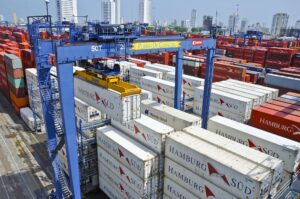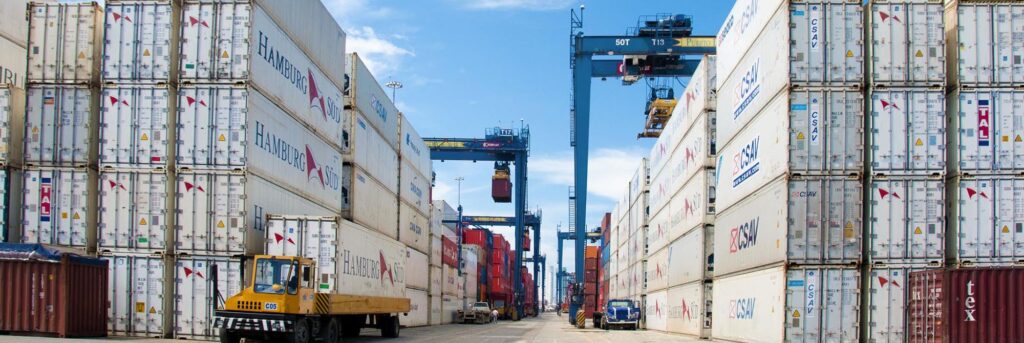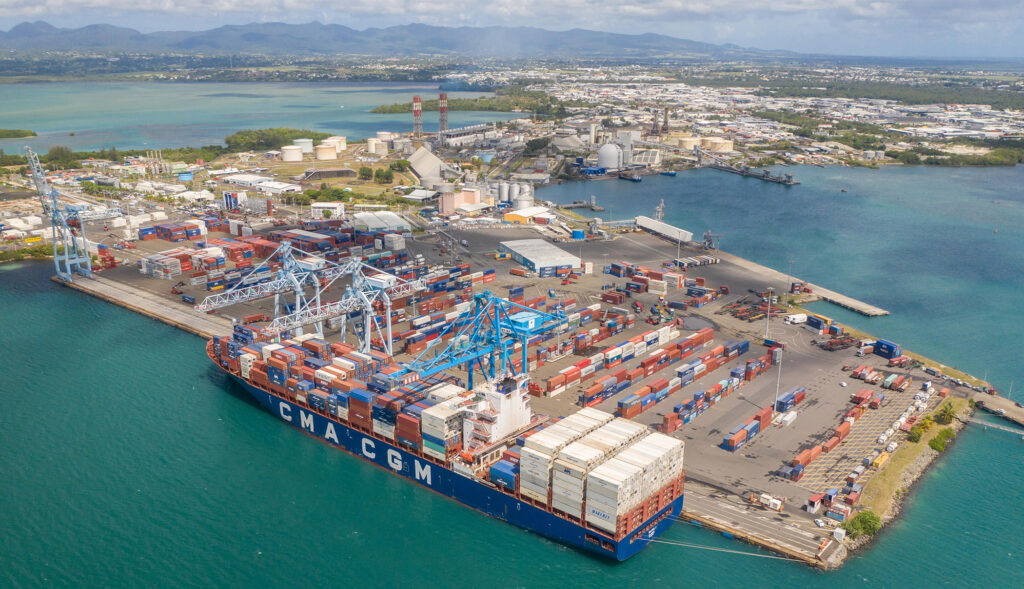Managing the ‘triple constraints’ ‑ cost, space, time
Sustained growth of the container market demands higher levels of operational efficiency from container terminals. The dynamics of international trade and logistics demands flexibility and adaptability of ports. As a consequence, the port industry is under pressure to upgrade; to provide cutting edge technology; and, to improve terminal efficiency and productivity. Among these challenges is management of the triple constraints: cost, space and time. These constraints – cost, space and time ‑ must be regarded as strategic issues for port management.
By Curtis Dennie *
2019, March 1: The accelerated growth of containerization, that is the system of intermodal freight transport using containers, has expanded the role of container terminals. Consequently they have become crucial links in intercontinental supply chains.
The sustained growth of the container market therefore demands higher levels of operational efficiency from container terminals.[i] The dynamics of international trade and logistics demands flexibility and adaptability of ports. As a consequence the port industry is under pressure to upgrade, provide cutting edge technology and to improve terminal efficiency and productivity[ii].
Container terminals play a critical role in a port’s infrastructure as they facilitate the economic development of a country. The year ahead therefore presents several challenges for Caribbean ports. Among these challenges is management of the triple constraints: cost, space and time.
These constraints – cost, space and time ‑ must be regarded as strategic issues for port management. They are more formidable at ports with an aging infrastructure, archaic labour restrictions and resource limitations. In some countries, the redevelopment of ports and the reduction of their container storage space have exacerbated the triple constraints.
To effectively address these constraints, organizational change is required. Organizational change is always difficult. However in ports it is made even more challenging. This is due primarily to the public service function of ports; political influence in management; and, a strong unionised environment.

Terminal Operations and the Working Port
The globalization of production and consumption and the advent of containerization have revolutionized the way that cargo is transported and handled. Ports serve as the main cargo transportation gateway for countries and are pillars of the national economy. The working port is therefore expected to facilitate trade logistics; keep operating costs low; while improving service quality and the effectiveness of operations.
The aim of ports should therefore be to optimize their terminals by determining the best mix of operating strategies for crane control, stacking area, handling area and resource management for every system load that can be handled by the terminal.
It helps to be reminded that a container terminal is a complex system with three subsystems: seaside operations, yard operations, and landside operations. All three interact.
* Seaside operations, which include the berthing operations and the loading and unloading of containers, interact with yard operations via internal transport equipment used to transport containers from/to the ship and to/from the storage yard.
* The yard operations manage the containers during the transfer between landside and seaside.
* Landside operations are characterised by activities for receiving and delivering inbound and outbound containers to and from the storage yard. The landside operations are broad in scope and include the gate, parking, office buildings, customs facilities, container freight station with an area for stuffing and stripping, empty container storage, container maintenance and repair area among others, depending on the terminal.
While each of the three subsystems can be viewed as an independent entity, the interlocking nature of the relationship is unavoidable and plays a crucial role in the efficient management and operation of a container terminal.
Effective management of these three subsystems is fundamental to the success of port operations. Port management therefore must conduct a holistic overview of their terminal operations and continually seek to develop strategies to improve efficiencies.
Yard Management Operations
The research area of yard management has attracted the attention of academia and industrial practitioners. Experts have argued that the decisions made at strategical, planning and operational level in yard management have an impact on a port’s operational performance. [iii]

Efficiency of yard operations can be used to measure or assess a terminal’s competitive strength because it directly affects the performance of the entire terminal.[iv] Yard management is the beating heart of terminal operations. It bridges the gap between quay side and gate operations.
In yard operations, three types of container flows are distinguished: import containers (that arrive on vessels and leave on inland transport modes); export containers (that arrive on inland transport modes and leave on ships); and, transhipment containers that arrive and leave on ships. Typically, empty, refrigerated (a.k.a. reefers) and containers with hazardous materials are assigned to specific areas within the yard. As a result of the improvement in quay side equipment and technologies, the bottleneck of operations has shifted from quay side to the yard.[v]
Yard management influences the financial as well as the operational well-being of a port. Acquisition of the right equipment and appropriate technologies is therefore critical.
Challenge of Costs Constraint
Ports are exposed to uncontrolled equipment costs in the container retrieval process and the restacking of the yard. The cost of port operations, are often hidden but are manifested by uncontrolled and unproductive activities. Managing costs and scope of operations remain the challenge of operations managers. There are costs associated with the stacking problem and there are equipment costs that are associated with spatial management.
Stacking creates a time-consuming problem if the aim is not to properly store incoming containers so that the time spent in future handling (re-location or pre-marshalling) is kept to a bare minimum. Thus direct costs can be significant since the number of moves that are involved in the shifting of containers have an impact on the cost of operations.
Yard management undoubtedly has an impact on a terminal’s bottom line. Terminal operations face many other operating costs, including the cost of discharge by the crane; the transportation costs between quay side and the storage area; and, the retrieval costs.
Cost management is a concern when the equipment and operators are engaged in non-earning time. Cost management strategies must be employed since the constraint of space is a further limitation to the operations. The size of most Caribbean ports limits the storage space that is available. This limitation impacts the retrieval of containers post vessel operations to facilitate the delivery. Ports must confront the maintenance costs of equipment and yard infrastructure. These factors contribute budget variances due to their unpredictability.
Challenge of Space Constraint
The lack of sufficient container storage space is one the critical challenges facing ports today. The marine terminal landscape in the Caribbean is currently characterised by a lack of real expansion possibilities. Ports must therefore optimize their operating strategies in order to increase the capacity of the terminal.

The design of the port and its equipment capabilities limit the productivity of the terminal. The increase of FEU imports over TEU in some ports further compounds the problem of space. The basic unit of storage space is called a “slot”, into which can fit one 20-foot container or one 40-foot unit.
Yard management is complex and, in practice, incorporates two interrelated decision problems. The first is the space allocation problem, to determine the storage. The second is the deployment of the appropriate number of yard cranes.
Multi-level stacking in blocks is one of the solutions most commonly used by terminal operators to increase the storage capacity. This is due to the demand for space and the number of ground slots are not enough. In some ports containers are stacked between 4- 5 tiers high. Ports can employ a segregation, a non–segregation strategy or linear stacking. However, increasing the yard storage productivity and density has some negative effects on yard performance because over-stacking requires additional handling movements during pickup operations. As a result, during the retrieval process, the yard cranes must perform one or more relocation moves. Such relocations (also called reshuffles) are costly for port operators and result in delays in the retrieval process. The problem of space constraint does not impact the operations only but may also create delays in the clearance process, which may have financial implications for importers.
As it is observed, the stacking problem is really complex because of the uncertainty regarding which container will be retrieved first. The other factor is that the stacking is problematic since the arrival time of consignees’ trucks at the terminal is random. Spacial management has an impact upon the port’s resources since the deployment of equipment has cost implications.

Challenge of Time Constraint
Ports are pressured to execute the discharge and loading of vessels as quickly as possible.
Vessel schedules for various ports include an estimated time of completion and an estimated time of arrival at the next port. The delay of a vessel carries many costs implications mainly due to the time factor. These costs relate to the loss of berthing space, the loss of market share, vessel operating costs (bunkers etc,) and port related costs.
Successful port operations rests heavily on the productivity factor. Ports and carriers regard berth productivity as an important performance indicator of the operations. Indeed, container moves per hour is an international measure of port efficiency.
The window between the discharge time at one port and the scheduled berthing time at the next is limited. Carriers must therefore make critical operational decisions. These decisions are generally referred as disruption management. The carrier may choose to discharge the cargo and limit the number of empty units for loading. This is known as the “cut and run” approach. Carriers may swap ports of calls or skip ports of calls with a view to prioritising a valued market.
The time allocated for berthing naturally creates constraints on port operations (because of the commitment made for the berth space). Yard planning prior to vessel arrival helps greatly in effective management of operational time and contributes greatly to port efficiency.
Breakdown of equipment or industrial action during the operations contributes to unproductive time and is a challenge that must be addressed by effective supervision of an properly documented repair and maintenance programme. In most ports, deliveries to consignees is limited to the working hours of the port. This means that, generally, there is a narrow window to facilitate the truckers. This is an industrial relations issue and must be addressed in appropriate negotiations.
Time is a critical component of port operations. Several ports have introduced terminal operating systems (TOS) to reduce time, costs and improve operational efficiencies. This is advisable.
Gate operations
Efficient gate operations are crucial to intermodal freight terminals. Their importance is integral to the efficiency of the terminal. Inefficient gate operations can spill over to the surrounding public roads causing serious safety and congestion problems. They also negatively affect the reliability and performance of carriers, shippers and terminal operators. Conversely, experts have argued that efficient gate operations reduce congestion at terminal gates, reduce consignees costs that are due to delays, and restricts environmental risks of pollution.
Gate operations can be categorised into two planning levels: the strategic level (e.g. capacity expansion), and the tactical/operational level (e.g. extending gate hours, appointment systems etc).
Gate appointment is a truck reservation system that provides a certain number (limited by capacity of the terminal) of reserved transactions during a specified time slot. To be effective an appointment system requires the dedication of shippers, drayage operators and ports. Gate appointment systems can be very effective in controlling the random arrival of trucks; modifying the peak hours of demand; minimizing congestion of idling trucks; and, improving the utilization of the terminals’ capacity (both at the delivery area and in the storage yard).
In order for a gate appointment to be to be successful, further strategies should be in place for processing the trucks arriving before or after their appointment time. Gate appointment systems have the potential to dramatically improve operations inside the terminal as well as at the gate and contribute towards the management of the triple constraints.
The key to developing effective gate appointment systems is to ensure participation from all key stakeholders; investment in appropriate technologies; and, trained human resources.
Summary conclusion
Ports in the Caribbean are mostly limited by the hinterland due to their location in major cities. Some ports may face the dilemma of making the decision to expand while volumes remain stagnant. Ports are capital intensive facilities thus the expansion of the physical infrastructure as well as expanding the hinterland road network present economic challenges to national governments. These physical infrastructures are the main determinants of port productivity, resiliency and efficiency. Several authors have argued for the adoption of the landlord model of port ownership whereby the engagement of the private sector can absorb the investment risks.
In the midst of this limitation, ports confront the challenge of culture. Changing behaviour must be an issue that must be confronted by ports since there are costs implications.
The mathematical complexities that are associated with storage and yard planning demands that ports invest in technology, equipment and training. Ports must train and deploy specialist yard managers to fully maximize available space, increase efficiencies and reduce costs. Ports must employ the stacking model that best fits their environment and the available resources.
Pre-planning of vessel operations with the Agent improves coordination of activities and the assignment of yard storage space. This activity creates predictability in the environment in terminal operations.
The challenge of the triple constraints may best be approached by organizational change. A change management strategy supported by efficient planning, organizing and controlling resources will be required. The critical success factors will be process management, technology, infrastructure, human resource and strong collaboration between the port, trade unions and Shipping Agents. Existing terminal facilities can only be optimised when all users contribute to this process with timely information exchange and intelligence sharing. Carriers ask for fast turn-around times irrespective of vessel size. Ports must develop operations that can be planned and scheduled in order to meet and exceed the expectations of all port users. []
______________
NOTES
[i] Tan & He (2016) Integrated Yard Space Allocation and Yard Crane Deployment Problem in Resource-Limited Container Terminals
[ii] Nyema (2014) Factors influencing container terminal efficiency A Case Study of Mombasa Entry Port
[iii] Ibid 1
[iv] Alcade (2014) Strategies for improving import yard performance at container marine terminals
[v] Zhen et al (2 013) A Review of Yard management in Container Terminals. Industrial Engineering & Management Systems Vol.12.no.4
______________
BIBLIOGRAPHY
- Tan & He (2016) Integrated Yard Space Allocation and Yard Crane Deployment Problem in Resource-Limited Container Terminals
- Nyema (2014) Factors influencing container terminal efficiency A Case Study of Mombasa Entry Port
- McGuire et al (2010) Relieving Congestion at Intermodal Marine Container Terminals: Review of Tactical/Operational Strategies.

* Curtis B. Dennie, MSc, MBA, PG.Cert., is a Management Consultant and Research Officer at the Caribbean Association of Banks





